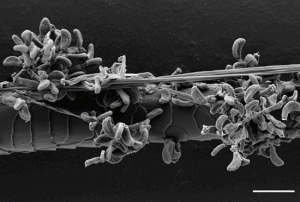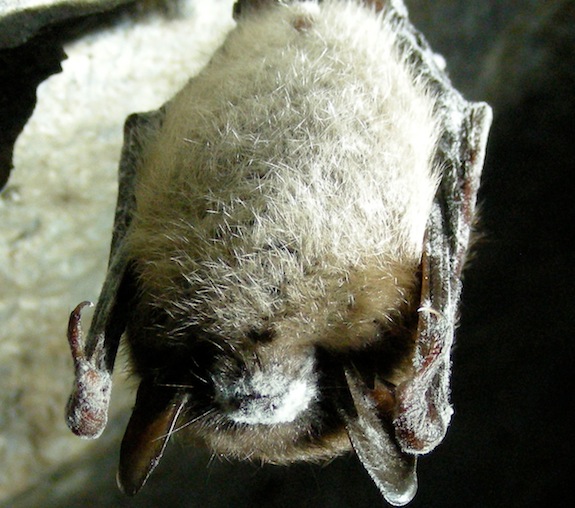White-Nose Syndrome Kills Social Bats Most Frequently
Scientists have found that bat species that hibernate in clusters are more likely to be struck by the dreaded disease and may be at risk of extinction
A hibernating bat stricken with white nose syndrome. Photo via U.S. Fish & Wildlife Service
If you head outside to enjoy a pleasant evening this summer and look carefully, you might notice something subtle missing from the darkening sky: bats. Since 2006, bat populations across the Northeast U.S. have been declining due to the spread of the poorly-understood disease known as white-nose syndrome. The fungal disease, which attacks bats during hibernation and has caused up to 95 percent of particular colonies to die off, has experts concerned that several bat species are headed towards extinction. In 2008, bat expert Alan Hicks said “Most bat researchers would agree that this is the gravest threat to bats they have ever seen.”
Now, according to a study published earlier this week in the journal Ecology Letters, we finally have a better understanding of what makes some species more vulnerable to white nose syndrome than other—and how we can act most efficiently to save them. A team of biologists from the University of California, Santa Cruz examined bat population data collected over the past three decades to determine which of six species have suffered the most from the disease. Their findings indicate that bat species that hibernate in the largest, most social groups tend to die off more quickly and may be on the road to extinction.

A microscopic view of a bat hair colonized by Geomyces destructans, the fungus responsible for white-nose syndrome
“We found that in the highly social species that prefer to hibernate in large, tightly packed groups, the declines were equally severe in colonies that varied from 50 bats to 200,000 bats,” said co-author Marm Kilpatrick in a press release. “That suggests that colonies of those species will continue to decline even when they reach small population sizes.”
The scientists speculate that the close proximity of hibernating bats allows the disease to be transmitted more easily. The fungus, which grows on the bats’ skin during the winter hibernation period, causes a loss of fat reserves, damage to the wing membranes and unusual behavior, even leading some hibernating bats to try flying during the winter. The combination of these symptoms leads to increased bat mortality, which can trigger disruptions throughout local ecosystems—including some we (unfortunately) feel firsthand, like higher amounts of mosquitoes and other insects that bats prey on.
The study also revealed a few pieces of good news, though. Bats that typically hibernate alone (such as the Eastern pipistrelle) experienced much more gradual declines in population than the gregarious species. After several years of declines in the populations of these more solitary bats, their population numbers generally leveled off, reducing the odds of extinction.
Moreover, one particular bat species–Myotis lucifugus, or the little brown bat, the most common species in the Northeast—bucked expectations by actually changing its behavior to ensure a greater survival rate. Although in the past, the species generally preferred to hibernate in clusters and has suffered a major population collapse since the onset of the disease, the researchers now observe roughly 75 percent of individuals roosting solo, which has reduced transmission rates significantly. ”Our analysis suggests that the little brown bats are probably not going to go extinct because they are changing their social behavior in a way that will result in their persisting at smaller populations,” Kilpatrick said.
The study also looked at the variance in disease rates among microclimates within caves, and found that bats hibernating in cooler and drier sites were less likely to be stricken by the fungus. The researchers are unsure why these locations may serve as refuges from the disease and note that more research into transmission is necessary.
The new findings could go a long way in helping us actively conserve bat populations to avoid extinctions. ”Managing disease outbreaks appears to be a daunting task, given the complexity of most ecosystems,” said Sam Scheiner of the National Science Foundation, which funded the study. “This study, however, shows that in fact we can identify the key factors needed for adequate management.”
Some evidence suggests that the fungus can be carried on the clothing of humans entering caves, and in some locations, disinfecting clothes is now required, while other caves have been closed entirely. As a result of the study, immediate conservation efforts can be focused on the species that face the greatest danger.
/https://tf-cmsv2-smithsonianmag-media.s3.amazonaws.com/accounts/headshot/joseph-stromberg-240.jpg)

/https://tf-cmsv2-smithsonianmag-media.s3.amazonaws.com/accounts/headshot/joseph-stromberg-240.jpg)